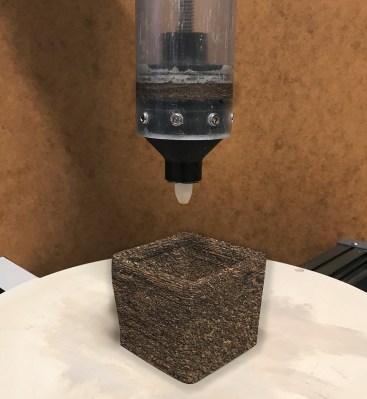Ding dong, the office is dead — at least we hope it is. We miss some of the people, the popcorn machine, and the printer most of all, but we say good riddance to the collective noise. Thankfully, we never had to suffer in an open office.
For many of us, yours truly included, home has become the place where we spend approximately 95% of our time. Home is now an all-purpose space for work, play, and everything in between, like anxiety-induced online shopping. But unless you live alone in a secluded area and/or a concrete bunker, there are plenty of sound-based distractions all day and night that emanate from both inside and outside the house. Headphones are a decent solution, but wearing them isn’t always practical and gets old after a while. Wouldn’t it be nice to be able to print your own customized sound absorbers and stick them on the walls?

Sure, you can already buy prefabricated panels, or make your own out of fiberglass and fabric, or even just staple some egg crate foam to the wall and call it a day. But the problem is that most modern sound-absorbing materials like mineral wool, cellulose, fiberglass, and convoluted foam aren’t sustainable, nor are they easy to recycle.
A research institute in Germany is working to develop fungal-based sound absorbers that are entirely organic. The concept is based around mycelium, the wide-spreading underground root network of various fungi that is made up of fine, filament-like fibers called hyphae.
The team is led by Julia Krayer, a project manager at the Fraunhofer Institute in Oberhausen, Germany who has long been working with biomaterials. Julia and the team grow their own hyphae in the lab, and mix it with a plant-based substrate that’s made of straw, wood, and food production waste.
The mixture is 3D printed in the desired shape, and then the hyphae go to work, spreading throughout the substrate and solidifying the structure in the process. Once the hyphae start poking through the surface, the print is dried in a kiln to kill off the fungus. The resulting material has open cell walls that absorb sound just as well as their synthetic counterparts, and may potentially surpass them in the future given the nature of 3D printing.
There’s No Ceiling to the Flexibility of Mycelium
Okay, so printing your own hexagonal or other fun-shaped sound absorbers might be a bit far off, unless you have access to a kiln or can dedicate an oven to drying your home-brewed acoustic panels. Mycelium begins to decompose around 435 °F (225 °C), so a regular kitchen oven wouldn’t be completely out of the question. But you probably wouldn’t want to use it for food after that.
As we’ve seen over the years, mycelium is quite the multi-purpose material. It can be used as an alternative to fiberglass insulation in walls and attics, or molded into canoes that can still produce fruiting bodies. And companies like Adidas are trying to use mycelium as a cruelty-free and sustainable alternative to leather.
A company called Ecovative Design are taking things a bit further by making biodegradable alternatives to plastic and packaging as well as leather, cosmetic sponges, insulating material for gloves, and foam for footwear. Would you wear mushroom leather shoes or warm your fingers in a fungal fashion statement? They might grow on you. Let us know what you think in the comments.















So, Jules Verne and Arne Saknussemm were ahead of their time?
“We miss some of the people, the popcorn machine, and the printer most of all, but we say good riddance to the collective noise. ”
This must be the dot com time because we never had a popcorn machine, or even a pool table.
Also how much of this “work at home” is tax deductible never mind wear and tear that doesn’t show on the bosses ledger.
We have a popcorn machine at the office, from post-dot com time. It however hails from a time before COVID, when first-fridays were a thing.
In the U.K., there’s a fairly reasonable working from home allowance which your company can pay you tax free with no paperwork.
There’s also currently a dispensation (no tax) for employees to expense home office equipment without loads of paperwork (normally you pay tax on expenses then reclaim it) – though as ever it’s easier if your camp any just buys it for you.
How much do firms pay for electricity, janitorial, and real estate?
Popcorn is dirt cheap in comparison.
Indeed. It is as though some of us got dropped off at a discontinued bus stop. But to hear the “talk,” it could strike you that it was only four people, and everyone else still got the bus.
Why do you think that roasting mycelium would damage the oven? It can’t be worse than burning a cake, which someone I know managed to accomplish, without lasting ill effects?
Like spore concerns …
I have exactly nil of those, as it requires fruiting bodies to be present, which does not appear will be the case, and then it requires them to not die, at a temperature specifically calculated to kill them. May as well worry about your oven growing mushrooms from the ones on top of your frozen pizza.
Indeed, though if you use your oven for questionable things between food use a proper clean is essential – it might be safe, but dried burned up junk from previous non-food use probably tastes awful, and might not really be safe to eat…
Morels don’t have to fruit to reproduce, although can (yay!) go that route.
Maybe it’s because of the other ingredients. Some may give off chemicals that are not desirable in our food? (not sure, just what I thought when I stumbled over the same question as you)
Yes, I see no problem if it’s all recently organic (Like organic chemistry isn’t) there’s no big difference to foodstuffs, but if it’s got something less recently organic, like plastics in it as a binder, those might tend to leave unpleasant, if not toxic residue.
There’s plenty of organic products I wouldn’t want to cook in my oven – yew for example. I might be over cautious, but in the absence of clear safety, caution is not a bad approach.
The danger probably has more to do with the substrate.
Ah, the hazards of rice hulls.
We really need an acronym so that Shade Tree Engineers can express concern about a project quickly and easily so we can all move on; something like YGGYK (Yer Gonna Git Yerself Killed) or in extreme cases YGGYFSK (Yer Gonna Git Yer Fool Self Killed).
Excellent!
I don’t think that you need to decompose the mycelium, you just have to dehydrate/kill it so it doesn’t keep on growing, therefore much lower temperatures would be sufficient.
Perhaps decomposition is in this application needed to assure space mycelium kept is vacated, because sound absorption needs voids.
Most of the foam in those panels and egg crate like designs is EVA foam, which is fairly recyclable, despite the supposition that it’s not.
It’s not recyclable if your council won’t take it. Our council only takes a very limited range of plastics, and the same plastic in a different shape (e.g. foam), they’d reject.
I mean, sure it’s stupid (of course, it’s a socialist council), but if they won’t take it, you can’t recycle it.
Flammability?
Flammability?
It looks like it would be similar to cardboard. And I can’t imagine that nailing sheets of cardboard with big air pockets all over the walls meets any fire code.
Soak it in a borax solution, it will make it char rather than burn and also helps to kill the fungus and prevent other fungus growing in it later due to humidity.
Or treat/kill with thyme oil. Cost?
My current favourite is leaning towards wool for interior, rigid/semi-rigid mineral wool sheets for exterior.
But if you put borax or other flame inhibitors it end up as non recyclable…
Borax can wash out, plus it would still be reusable if ground up and used as a cavity infill.
You have a popcorn machine in the office? Jeeeze
Got Flavacol?
It’s all fun and games until your podcast co-host discovers a previously unknown fungal allergy while on a live mic…
i think you’re right. The linked article examines only thermal properties, not composition and relevant hazard risks at various temperatures. When referring to remaining substances it always “presumes”.
In the Netherlands Mycelium is even used to construct coffins.
There are some scientists who work on self healing concrete with the help of Trichoderma reesei.
Mycelium is good for everything, even faster than light travel …
You wouldn’t want to package cheese in a mycelium-based container. But there sure is a need for packaging that doesn’t consist of plastic.
Isn’t this behind the times? The CBC today had a story that Stella McCarthy showed off a top made of this stuff.
It’s not a new thing, it’s already used for soundproofing, and either already used for packaging, or work done in that area. I gather going clothing they are still working on it.
So apparently, the future is this stuff.